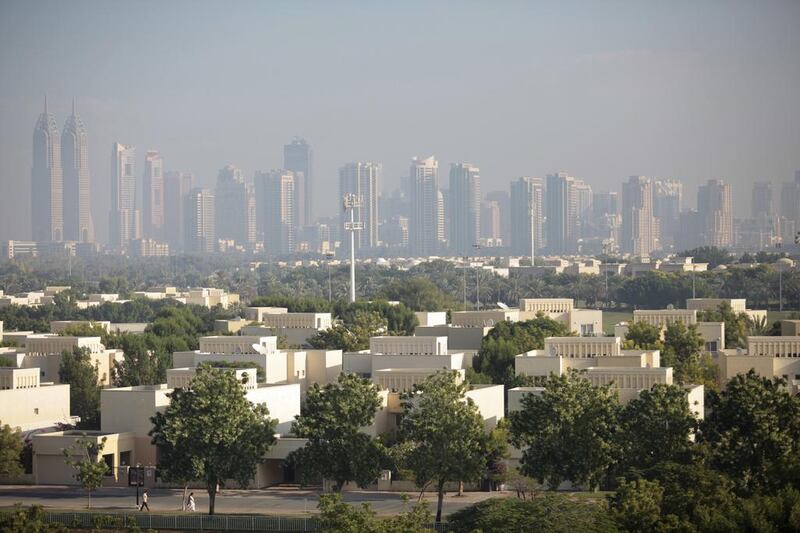Unreliable and confusing data is distorting the UAE property market and risks inflating the market.
That is the fear of some industry analysts who say investors are buying into vastly inflated figures that are fuelling speculation.
There is still little publicly available official house price information for investors to tap beyond periodic reports from local and international brokers.
Instead property brokers, property data companies, listings websites and banks fill the information vacuum pushing out their own statistics on sales and rents, which often contradict each other significantly.
“In the current market where everybody is getting excited about real estate, asking prices rise more quickly than achieved prices, which means that the gap between the two is widening,” says Craig Plumb, the head of research at Jones Lang LaSalle’s Dubai office. “The lack of reliable information does cause distortion to the market. We believe that asking prices are currently probably around 20 per cent higher than achieved sales prices.”
According to the property broker Asteco, house prices in Dubai increased by nearly 60 per cent last year. The website propertyfinder.ae reported a 45 per cent increase in average values in Dubai’s key neighbourhoods over the same period. And the property data company Reidin reported that they rose 22 per cent over the year.
One reason for the significant discrepancies could be in the information that the three companies are providing.
While propertyfinder.ae only analyses the asking prices provided in all 270,000 property listings it carried last year, Asteco attempts to provide actual sales price data, which is provided by its own property brokers combined with other market information. Reidin uses a combination of sale prices along with data provided by its own team of researchers who act as mystery shoppers and question property managers to find out information.
“At the moment there is very little that individual buyers can do to find out reliable information about the market, but we believe this is an opportunity for the government and the industry to work together to provide more reliable information,” added Mr Plumb. “In Dubai you can look on the Rera website and see how much rents are in the area. It would be great if there was something similar for prices.”
He adds that a lack of information about the amount of new homes being built has also created difficulties for developers because they tend to underestimate the number of new homes coming to the market through other developers and build more homes than the market can absorb.
Both the Dubai Land Department (DLD) and Statistics Centre–Abu Dhabi (Scad) provide information about property development in the Emirates.
DLD, the government body responsible for registering all property transactions in Dubai, publishes daily transaction information, quarterly totals of the value of property changing hands and some information about sales purchased through cash and mortgages.
A DLD spokeswoman said that the body would continue to provide the information but she knew of no plans to provide more detailed information.
In Abu Dhabi, Scad publishes information about the number of housing completions each quarter.
Jerry Oates, the general manager for Asteco’s Abu Dhabi office, says the market is thirsty for data.
“The lack of official data makes everyone more reliant on rumours and people’s opinions,” Mr Oates said. “We find a lot of institutions ask for our data as soon as it comes out because schools, offices, occupiers will use this data as the benchmark for their HR in terms of allowances. It’s those sorts of things that become more important where there is so little data.
“If I put a confidence level on our research it would be about 80 to 90 per cent. In Abu Dhabi it’s about as good as it can get without getting a Land Registry registering every one of the deals, having access to the Tawtheeq system, which nobody has.
“If there was more reliable data you would probably get a lot more funds coming into the market because they look for data and growth analysis and are always thirsty for more data.”
Ahmet Kayhan, the chief executive of Reidin, whose data is used by the likes of CBRE and Jones Lang LaSalle, says that even though his index uses a mixture of asking prices and achieved sales prices, the information supply is weighted to ensure a robust outcome.
“It’s all about statistics,” he says. “We have access to 12 million property data points per month from 35 countries, so if you have enough data points you can get a pretty clear picture of what is going on. In the UAE we use a mixture of asking prices and transactional data but we weight the information so we can take the difference into account in our figures.”
And Ann Boothello, a marketing specialist for property at dubizzle.ae, adds that publishing an asking-price index provided useful information to the market.
“We provided data as it is because our users tell us that they want to see this data,” she says. “Lots of our users come onto the site just to gauge how the market is doing so we provide it almost as a duty.”





